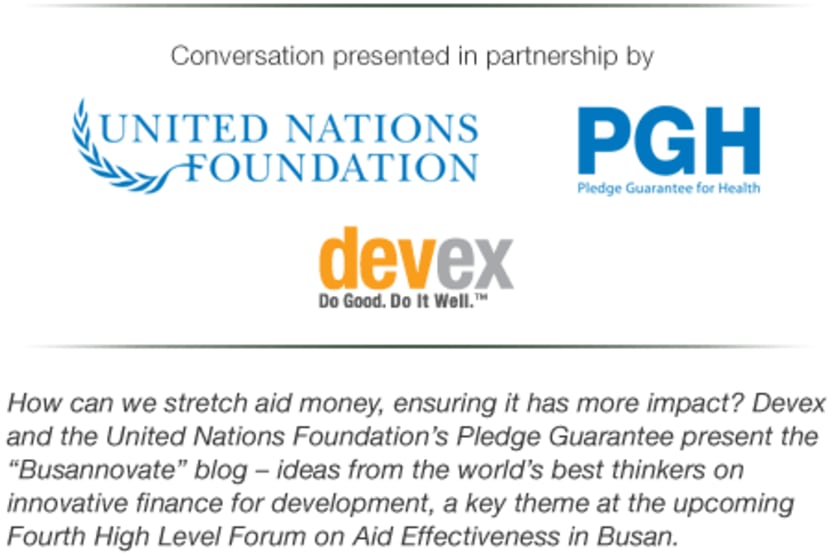
The High Level Forum on Aid Effectiveness in Busan, South Korea, has renewed interest in innovative ways to use official development assistance to stimulate economic activity and increase foreign direct investment. A special “building block” is planned in Busan to focus on the private sector contribution to development.
In the 1970s, debate raged throughout the development community as to whether economic growth actually reduced poverty. Many instances were cited where growth (much based on extractive industries) exacerbated a poor distribution of wealth, creating major tensions within society. The argument extended to the controversial role of multinational corporations and to great doubt that “trickle-down economics” would ever relieve poverty.
Remnants of that debate are still heard, but the new consensus is that inclusive growth is what is needed for poverty reduction. Inclusive growth requires the creation of jobs. Cold War ideological debates are no longer seen as providing any answers. It is no longer open markets versus centrally planned economies. The consensus today is that developing countries must generate wealth through viable private markets, the appropriate degree of government oversight and regulation and human development that produces an efficient, educated and healthy workforce.
The discussion over innovative financing that will create the conditions for inclusive growth has been going on for many years, but there is a renewed interest in the subject now that donor nations are feeling the pinch of contracting economies. Ironically, the 2010 figures on official development assistance – nearly $130 billion – represented the largest amount ever.
But projections by the OECD Development Assistance Committee are that the next five years will see a leveling off. Thus the push to find ways to stretch the ODA dollar and to combine it with private sector resources.
Many of the suggestions relate to the leveraging effect of loans and guarantees. Given the real need for infrastructure in the developing world — power, telecommunications and transport — many of these schemes involve the creation of special funds to set the stage for investment both by governments and private companies.
ODA is seen as a source for feasibility studies, some of which cost much more than current facilities can fund. This is not really new. Development cooperation agencies have created facilities over the years to offer guarantees and government loans to encourage private sector engagement. The agency for which I was once responsible, the U.S. Agency for International Development, still has a thriving guarantee program started on my watch. In the early days, it spun off organizations such as the Trade and Development Agency and the Overseas Private Investment Corporation, or OPIC.

Today, innovative financing discussions lead to suggestions for public-private partnerships, advance market commitments, a variety of ideas for taxing transactions to raise money for investment, infrastructure funds and mobilizing domestic resources through more effective tax systems. Truly innovative pioneers like Muhammad Yunus and Hernando de Soto continue to offer fresh insights into the power of microenterprise and the need to legally empower the poor. Their work is distinctive because unlike other “innovations,” it proceeds from the inside out.
The “inside-out” work is truly developmental because it involves creating the environment for investment, both local and external. This involves the issue of risk. Guarantees, loans and risk insurance can reduce risk only up to a point. The real risk for investment in developing countries is in the arbitrary behavior that flows from weak institutions and systems. When a potential investor examines the economic and financial environment in a country, they look at the extent to which governments control economic activities and financial transactions. They look at tax systems, banks, customs operations and commercial codes. They observe the political stability of a country and they want to know whether the citizens of that country constitute a viable workforce, and whether there is a large informal economy.
Reducing these risks is the principal job of development cooperation. If scarce resources are diverted from this task, offering guarantees will be akin to pushing on a string. Even with government backing, the risk will most likely not be worth taking. So, innovation is something to pursue, particularly scientific innovation, new methods to raise capital, and the creation of new facilities to undertake feasibility studies. But not at the expense of abandoning the fundamentals of development work that forms the core of the partnership with developing countries.
Institution building and human development are investments that will reduce risk and create opportunity. The payoff will be a political and economic environment that will attract foreign direct investment and keep local wealth at home.
ODA is sometimes characterized as the opposite of innovation, a one-dimensional transfer of resources. It is nothing of the sort. ODA has been and will continue to be a source of innovation.
Want to read more about innovative financing for development? Check out Busannovate, a blog brought to you by Devex in partnership with the United Nations Foundation, and launched with a thought-provoking guest opinion by Nobel Peace Prize winner Muhammad Yunus.






